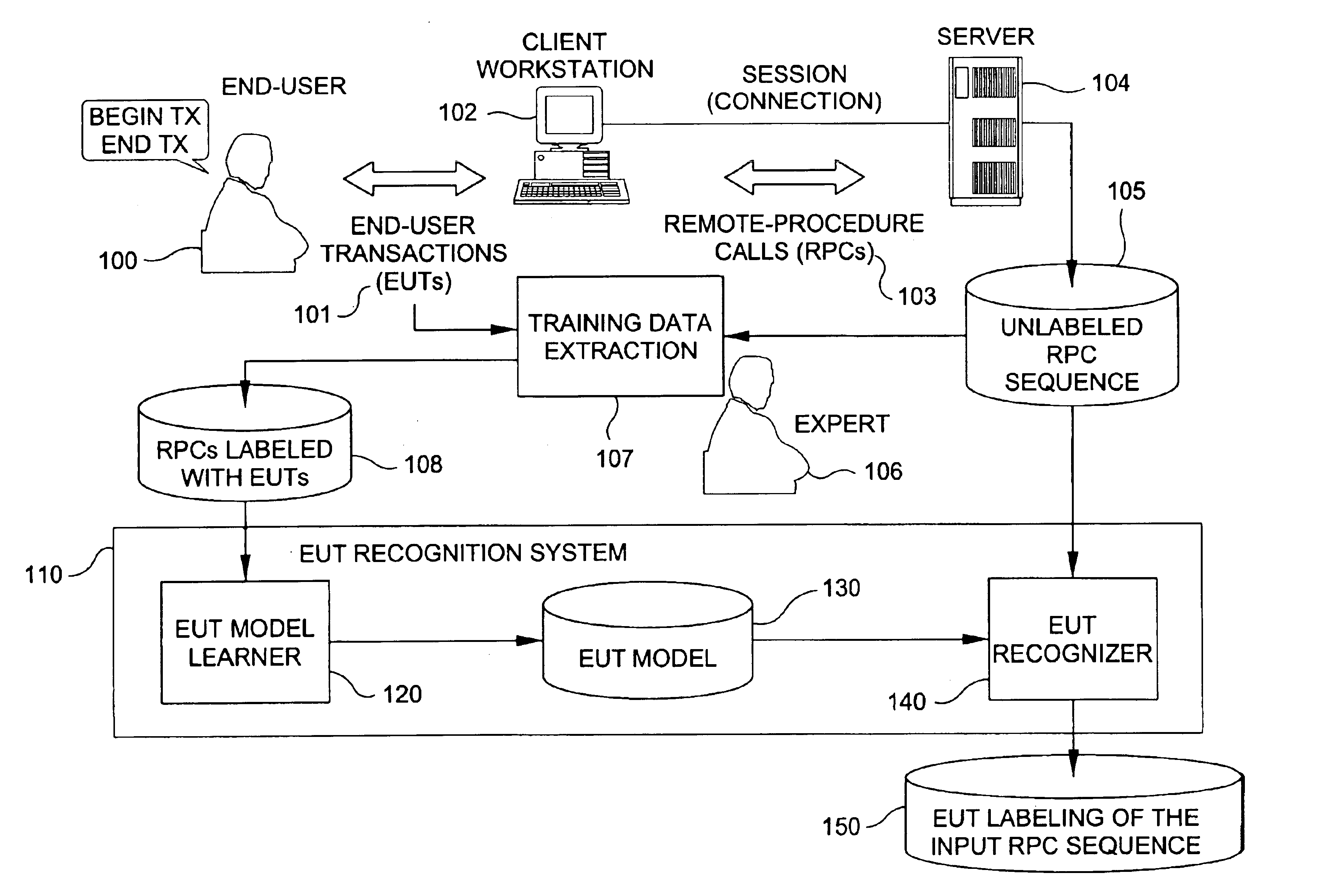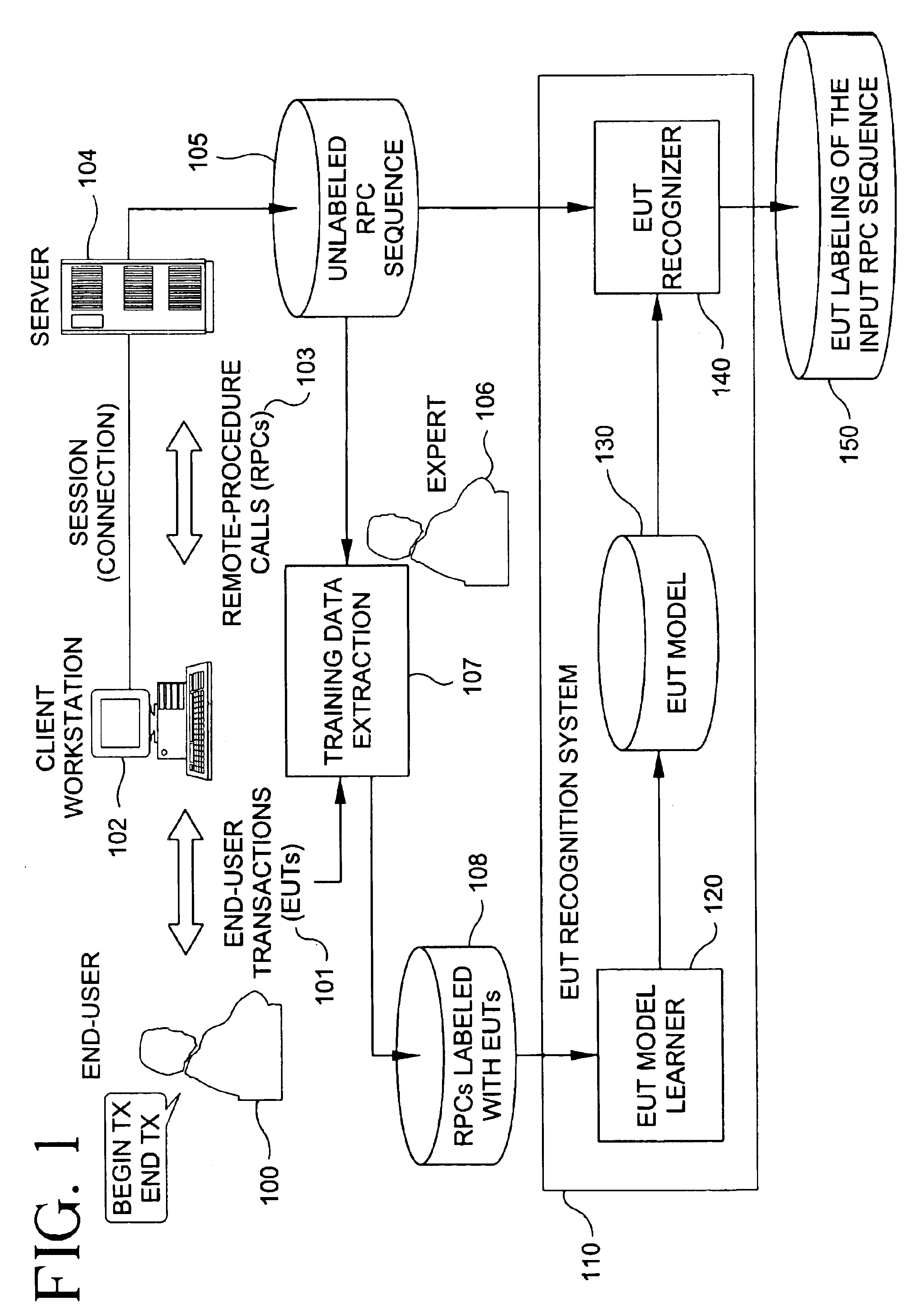[0006]The present invention provides methods and systems for recognizing end-user transactions comprising sequences of remote
procedure calls (RPCs) received at a
server. Such methodologies are important for providing good
quality of service (e.g., low response times) to end-users of information systems since, among other benefits, it allows to: (a) better quantify end-
user perception of performance; (b) create representative workloads; (c) provide better
resource management; and (d) improve the system's security by recognizing potentially dangerous user's behavior patterns.
[0007]The present invention proposes the use of machine-learning techniques to recognize EUTs, adapting several known methods to specific structural properties of our domain. Briefly, the EUT recognition problem has two parts. The first is segmenting the
stream of RPCs (from each user) into transaction instances (segmentation problem). The second is labeling the segments with the correct
transaction type (classification problem). The segmentation approach of the present invention uses a dynamic-
programming technique, which allows an efficient reuse of previous computations. For classification, the present invention uses the Bayes
Net framework, see, e.g., Pearl, Judea, “Probabilistic Reasoning in Intelligent Systems,” Morgan Kaufmann, San Mateo, Calif., 1988, the disclosure of which is incorporated by reference herein. A Bayes Net is a graphical framework for reasoning under uncertainty, which encodes probabilistic dependencies among entities of interest (represented by random variables) and allows making predictions about unobserved entities given the data. In the present invention, we want to predict the EUT type given an RPC sequence encoded by a set of features. A Bayes Net is a
directed acyclic graph (a graph with directed edges having no directed cycles) where random variables correspond to nodes and probabilistic dependencies are represented by edges. Each node has an allowed set of values called the domain of the variable. Bayes Nets are also called causal networks since directed arcs can be often interpreted as causal dependencies between the variables. The use of Bayes Net for classification is appealing because of several reasons. First, Bayes Nets are based on
solid probabilistic ground which allows a better interpretation of the results (to compare, for example, to some other models, such as neural networks, which have a less clear
semantics). Second,
Bayesian framework allows incorporating prior
domain knowledge, which is often as important as the information obtained purely from the data. Third, Bayes Nets allow learning causal dependencies rather than simply correlations in data.
[0009]Despite similarities with text classification, the EUT recognition problem is inherently more complex because it first requires segmenting the RPC sequence into segments representing different EUTs, and then labeling (classification) of those segments with EUTs. Some work on segmentation problem has been done in
speech recognition where a
stream of sounds is segmented into words, see, e.g., Jelinek, F., “Statistical Methods for
Speech Recognition,” Cambridge: MIT Press, 1998, the disclosure of which is incorporated by reference herein; and in statistical
natural language processing where a sequence of words must be segmented into phrases, see e.g., D. Beeferman, A. Berger, and J. Lafferty, “Statistical Models for
Text Segmentation,”
Machine Learning, special issue on
Natural Language Learning, C. Cardie and R. Mooney (eds.), 34(1-3), pp. 177-210, 1999, the disclosure of which is incorporated by reference herein. A standard approach in
speech recognition is to use Hidden Markov Models (HMM) for modeling dependencies between consecutive sounds. However, the domain of the present invention requires more complex dependence models, leading to a more general framework of Dynamic Belief Nets. Also, our domain poses particular structural properties not necessarily present in other domain, which can significantly improve the efficiency of our system.
[0018]Finally, the invention provides a method for automated marking of the EUTs at the
client and at the server sites, which allows generation of unlimited amounts of training data. This inventive process replaces the currently time-consuming process of generating training data by a human expert, or by
software that, again, uses manually constructed
heuristics. The inventive process also improves the quality of training data.
[0019]The present invention provides several benefits not present in the existing state-of-the-art performance management of distributed systems, some examples of which will now be given. First, automated EUT recognition provides a better way of quantifying the end-
user perception of the system performance, which is essential for a better service. Second, the EUT recognition results in realistic end-user models that can be used to create representative workloads, necessary for testing system's behavior under various circumstances. Third, realistic end-user and system models are essential for a better
resource management. Finally, such models can be used for providing a better security based on comparison of typical and non typical pattern in user's behavior.
 Login to View More
Login to View More  Login to View More
Login to View More 


